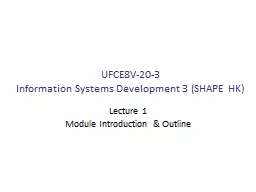

Information Systems Development 3 SHAPE HK Lecture 1 Module Introduction amp Outline Teaching and learning 1 hour lecture 12 hour workshop sessions emphasis on both individual amp working with others in workshop sessions ID: 625399
Download Presentation The PPT/PDF document "UFCE8V-20-3" is the property of its rightful owner. Permission is granted to download and print the materials on this web site for personal, non-commercial use only, and to display it on your personal computer provided you do not modify the materials and that you retain all copyright notices contained in the materials. By downloading content from our website, you accept the terms of this agreement.
Slide1
UFCE8V-20-3 Information Systems Development 3 (SHAPE HK)
Lecture 1
Module
Introduction & OutlineSlide2
Teaching and learning:
1 hour lecture
1-2 hour workshop sessions
emphasis on both individual & working with others in workshop sessions
Preparation will be required – readings and other material listed for each week (in the Resources column of the
module contents & outline page
)
should be done at home in preparation for the following week
Assessment:
Coursework - 1 piece - weighting 25% - will be an individual design and programming task. After hand-in, you will also be required to do a 15 minute presentation to your tutors illustrating and explaining your application.
Examination - weighting 75% - 3 hours
-
compulsory part 40%
- selective part 60%.Slide3
Course materials:
No specific set textbook is required – all course materials, lecture notes, workshop notes, readings and other resources are pointed to and made available via the
module contents & outline page.
However it is strongly recommend that you acquire one of the following texts for help with the assignment:
Nixon, Robin :
Learning PHP, MySQL, JavaScript and CSS: A Step-by-Step Guide to Creating Dynamic Websites
: O'Reilly Media, 2
nd
ed., 2012
Ullman, Larry :
PHP and MySQL for Dynamic Web Sites: Visual
QuickPro
Guide
:
Peachpit
Press, 4
th
ed., 2011
McLaughlin, Brett :
PHP & MySQL: The Missing Manual
: Pogue Press, 2011Slide4
Course Content Outline
:
PHP programming (including functions, sessions, forms processing, database integration & xml processing)
XML, XPATH, XSLT & XML Schema
Relational Database Theory
Structured Query Language (SQL)
E-R modelling
Data
Normalization
Systems Theory & Practice
Hard Systems & Soft Systems Modelling
Software Development Methodologies (Waterfall, Prototyping, Spiral, RAD etc.) Slide5
Presumed (prior) knowledge:
The practical (programming) part of the module will largely be focused on teaching Web Development (using PHP) and Database Theory / Practice.
However, we will not be focused on teaching HTML5/XHTML, CSS or JavaScript as it is presumed that students already have some knowledge of these technologies.
If this is NOT the case for you – you will need to use the on-line resources pointed to by the
module contents & outline page
and quickly learn these technologies in your own time.Slide6
Assignment (coursework) pre-amble:
Accounts for 25% of the overall mark.
A design and programming task using and refactoring a basic PHP based framework.
6-8 weeks allowed to complete task (tutor will notify about specific hand-in date)
15 minute presentation to tutors after hand-in.
Learning
objectives:
Use a range of web oriented software architecture and design principles.
Refactor a lightweight PHP-based web framework.
Understand and implement both static & dynamic software patterns.
Model and implement persistence and transactions via sessions, cookies & DBMS.
Understand & apply some security and integrity principles. Slide7
Sample exam question (from 2011/12 paper):
QUESTION
6i) Distinguish between the concepts of open and closed systems as used in systems thinking and briefly outline the key features of each type of system.
6
marks
ii) Identify and describe the three (3) essential systemic properties or attributes shared
by all
systems elements.
6
marks
iii) Briefly explain what is meant by the following five systems terms:
o reductionism
o holism
o feedback
o homeostasis
o environment
10
marks
iv) Identify and explain the four (4) underlying principles of Soft Systems
Methodology (
SSM).
8 marksSlide8
Questions? & Answers!